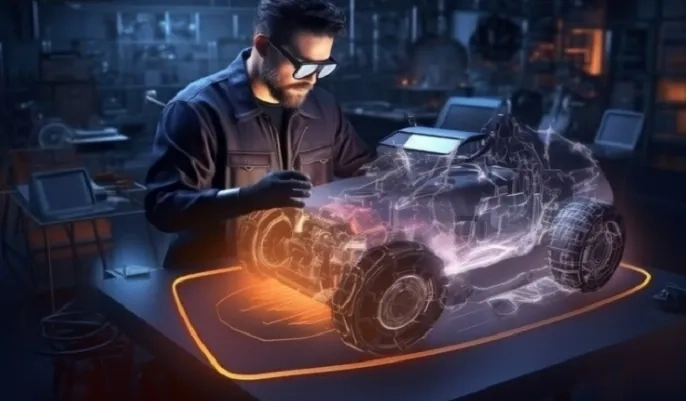AI in Automotive
The automotive industry is in the midst of a transformative era, driven by advancements in artificial intelligence (AI). From autonomous driving to enhanced safety systems, AI in automotive is reshaping the future of transportation, improving how vehicles are designed, manufactured, and experienced by users. This rapid evolution in AI-powered technology is pushing the boundaries of what cars can do, making them safer, smarter, and more efficient.
In this article, we will explore the various ways in which AI in automotive is redefining the driving experience. We’ll dive into autonomous driving, AI-powered safety systems, vehicle-to-everything (V2X) communication, and personalized in-car experiences, highlighting how these innovations are shaping the future of transportation.
The Role of AI in the Automotive Industry
AI is becoming a pivotal force in the automotive industry, with applications ranging from design and manufacturing to vehicle operations and after-sales services. AI algorithms, powered by machine learning, computer vision, and natural language processing (NLP), enable vehicles to perceive their environment, make real-time decisions, and improve their performance through data analytics.
AI in automotiveis not just limited to autonomous driving; it encompasses a wide range of technologies that enhance the driving experience, improve safety, and make transportation more sustainable. AI is also revolutionizing the manufacturing process by optimizing production lines and enabling predictive maintenance, reducing costs, and minimizing downtime.
Autonomous Driving: The Road to Self-Driving Cars
One of the most significant and transformative applications of AI in automotive is the development of autonomous driving technologies. Autonomous vehicles (AVs), often referred to as self-driving cars, rely heavily on AI to navigate roads, interpret traffic signals, and make split-second decisions to ensure the safety of passengers and other road users.
1. Levels of Autonomy
Autonomous driving is categorized into five levels, ranging from driver assistance (Level 1) to full automation (Level 5). At the higher levels of autonomy, the vehicle can perform all driving tasks without human intervention.
- Level 1: Driver assistance systems, such as cruise control or lane-keeping assist, which provide basic support but require the driver to be fully engaged.
- Level 2: Partial automation, where the car can control both steering and acceleration, but the driver must remain attentive.
- Level 3: Conditional automation, where the car can handle most driving tasks but may require human intervention in certain scenarios.
- Level 4: High automation, where the car can drive itself in most conditions without human input but may still have manual controls.
- Level 5: Full automation, where the car is completely autonomous, with no need for a steering wheel or pedals.
Many leading automotive manufacturers and tech companies are working towards achieving Level 5 autonomy, though most vehicles on the market today operate at Level 2 or Level 3.
2. AI-Powered Sensors and Perception
For a vehicle to operate autonomously, it must be equipped with a range of sensors, including LiDAR, radar, cameras, and ultrasonic sensors. These sensors work together to collect data about the car’s surroundings, enabling the AI system to create a detailed 3D map of the environment.
AI algorithms process this data in real-time, identifying objects such as pedestrians, other vehicles, road signs, and obstacles. Computer vision, a subset of AI, allows the vehicle to “see” and interpret the world around it, while machine learning models predict the movement of objects and make decisions based on current and past data.
3. Decision-Making and Navigation
AI-driven autonomous vehicles must make complex decisions about speed, lane changes, overtaking, and stopping, often in unpredictable environments. AI systems use deep learning to analyse vast amounts of data and learn from real-world driving scenarios. By processing this data, AI enables vehicles to navigate safely and efficiently, even in dynamic urban environments.
Navigation in autonomous vehicles relies on a combination of GPS data and high-definition maps, which are continuously updated to reflect changing road conditions. AI helps vehicles plan routes, avoid obstacles, and respond to traffic signals, all while prioritizing passenger safety.
4. Challenges and the Road Ahead
While the potential of autonomous driving is immense, there are still challenges to overcome, such as regulatory approval, public trust, and ensuring the reliability of AI systems in all driving conditions. Safety concerns remain a top priority, and extensive testing is required to ensure that autonomous vehicles can handle complex scenarios, such as adverse weather or unexpected obstacles.
Despite these challenges, the future of autonomous driving looks promising, with AI playing a central role in making self-driving cars a reality. As AI systems continue to improve, we can expect autonomous vehicles to become a common sight on roads worldwide, offering a safer, more convenient mode of transportation.
AI-Enhanced Safety Systems
AI in automotiveis not just about autonomous driving; it’s also transforming vehicle safety systems, making cars safer for both drivers and passengers. AI-powered safety features are helping to reduce accidents, prevent injuries, and save lives by providing real-time assistance to drivers.
1. Advanced Driver Assistance Systems (ADAS)
ADASare a suite of AI-powered technologies that assist drivers in various aspects of driving, such as collision avoidance, lane departure warnings, and parking assistance. These systems use sensors and AI algorithms to monitor the vehicle's surroundings and provide timely alerts or even take control of the vehicle when necessary.
Some common ADAS features include:
- Automatic Emergency Braking (AEB): AI detects potential collisions and automatically applies the brakes to avoid or mitigate an accident.
- Lane Departure Warning (LDW)and Lane Keeping Assist (LKA): AI systems monitor lane markings and alert the driver if the vehicle drifts out of its lane. LKA can also make small steering adjustments to keep the vehicle in its lane.
- Blind Spot Detection (BSD): AI-powered sensors detect vehicles in the driver's blind spots and provide visual or audible alerts.
- Adaptive Cruise Control (ACC): AI adjusts the vehicle's speed to maintain a safe distance from the car in front, reducing the risk of rear-end collisions.
2. AI and Predictive Maintenance
Another important application of AI in automotive is predictive maintenance, which helps prevent mechanical failures and extend the lifespan of vehicles. AI systems analyse data from sensors embedded in the car's components, such as the engine, brakes, and transmission, to detect signs of wear or potential malfunctions.
By identifying issues before they become critical, AI-powered predictive maintenance can alert drivers to schedule repairs or maintenance, reducing the risk of breakdowns and improving overall vehicle reliability. This technology also contributes to cost savings by minimizing the need for unexpected repairs and prolonging the life of the vehicle.
3. AI in Crash Detection and Response
In the event of an accident, AI systems can quickly assess the situation and take appropriate action. For example, AI-powered eCall systems automatically alert emergency services when a serious crash is detected, providing details about the location and severity of the accident. This rapid response can be life-saving, especially in remote areas where immediate medical attention may not be readily available.
Vehicle-to-Everything (V2X) Communication
A critical innovation enabled by AI in automotive is Vehicle-to-Everything (V2X) communication, which allows vehicles to communicate with each other (Vehicle-to-Vehicle or V2V) and with surrounding infrastructure (Vehicle-to-Infrastructure or V2I). This communication enables smarter and more connected transportation systems, improving traffic flow and reducing the risk of accidents.
1. Vehicle-to-Vehicle (V2V) Communication
AI-driven V2V communication allows vehicles to share real-time information about their speed, location, and direction with other vehicles on the road. This helps prevent collisions by providing drivers and AI systems with more comprehensive data about nearby traffic. For instance, if a car suddenly brakes ahead, V2V communication can alert the following vehicles to slow down or take evasive action, reducing the risk of rear-end collisions.
2. Vehicle-to-Infrastructure (V2I) Communication
V2I communicationenables vehicles to communicate with traffic lights, road signs, and other infrastructure. AI systems can use this data to optimize driving behaviour, reduce fuel consumption, and improve traffic management. For example, AI-powered systems can adjust vehicle speeds to catch green lights, reducing idle time at intersections and improving fuel efficiency.
3. AI and Smart Cities
V2X communication is a key component of smart city initiatives, where AI plays a central role in creating more efficient and sustainable urban environments. By integrating AI-powered vehicles with smart infrastructure, cities can reduce congestion, lower emissions, and create safer roads for all users.
Personalized In-Car Experiences with AI
The role of AI in the automotive industry is not limited to improving driving safety and efficiency; it’s also enhancing the in-car experience by making it more personalized and intuitive. Modern vehicles are equipped with AI-powered infotainment systems that offer a range of features designed to enhance comfort and convenience.
1. Voice-Activated Assistants
AI-powered voice-activated assistants are becoming standard features in many vehicles, allowing drivers to control various functions using natural language commands. These assistants, such as Amazon Alexa, Google Assistant, and Apple's Siri, can be used to control navigation, make hands-free phone calls, adjust climate control, and play music.
In addition to providing convenience, these AI assistants help drivers stay focused on the road by reducing the need to manually interact with buttons and screens.
2. Personalized Settings and Preferences
AI systems can learn from a driver's behaviour and preferences to offer personalized experiences. For example, AI can adjust the seat position, temperature settings, and entertainment options based on the driver's past preferences. This personalization extends to navigation as well, where AI can recommend routes based on the driver’s history or suggest nearby points of interest.
3. Predictive AI for Enhanced Comfort
AI-powered systems are also being developed to enhance driver and passenger comfort. For example, AI can monitor the driver’s behaviour and detect signs of fatigue or distraction. In such cases, the system can issue warnings or suggest taking a break. In more advanced scenarios, AI could take control of the vehicle in critical situations to ensure the safety of everyone on board.
The Future of AI in Automotive
The future of AI in automotive is full of possibilities. As AI technologies continue to evolve, we can expect further advancements in autonomous driving, vehicle safety, connected cars, and personalized in-car experiences. AI will also play a key role in the development of electric vehicles (EVs) and the integration of renewable energy sources into transportation systems, contributing to a more sustainable future.
At the same time, the adoption of AI in the automotive industry will raise important questions about data privacy, cybersecurity, and ethical considerations. Ensuring that AI systems are secure, transparent, and aligned with societal values will be critical as the technology becomes more widespread.
For those looking to stay ahead of the curve and learn more about AI in automotive and other industries, Oxford Home Study College (OHSC) offers a variety of free online AI courses. These courses cover topics such as AI in education, AI in healthcare, AI in cybersecurity, machine learning, OpenAI, Stable Diffusion, and much more. Whether you're interested in how AI is shaping the future of transportation or exploring AI's applications in other sectors, these courses provide a valuable opportunity to deepen your knowledge and stay informed about the latest trends in AI.
Conclusion
AI is transforming the automotive industry, from autonomous driving and enhanced safety systems to connected cars and personalized experiences. As AI continues to evolve, the possibilities for innovation in the automotive sector are virtually limitless, paving the way for safer, smarter, and more efficient vehicles.
The integration of AI in automotive is not only redefining the driving experience but also shaping the future of transportation as a whole. Whether you're a tech enthusiast, a car aficionado, or simply someone curious about the future of driving, understanding how AI is revolutionizing the automotive industry is crucial.
For those interested in diving deeper into the world of AI, Oxford Home Study College (OHSC) offers a comprehensive range of free online AI courses that cover the latest advancements and applications in the field. These courses provide the perfect platform to gain insight into how AI is transforming industries and how you can be a part of this exciting future.

